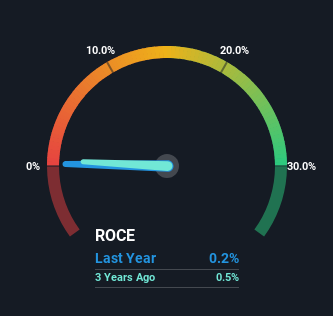- Hong Kong
- /
- Hospitality
- /
- SEHK:234
Returns On Capital At New Century Group Hong Kong (HKG:234) Paint A Concerning Picture
If you're looking at a mature business that's past the growth phase, what are some of the underlying trends that pop up? A business that's potentially in decline often shows two trends, a return on capital employed (ROCE) that's declining, and a base of capital employed that's also declining. This indicates to us that the business is not only shrinking the size of its net assets, but its returns are falling as well. Having said that, after a brief look, New Century Group Hong Kong (HKG:234) we aren't filled with optimism, but let's investigate further.
Understanding Return On Capital Employed (ROCE)
If you haven't worked with ROCE before, it measures the 'return' (pre-tax profit) a company generates from capital employed in its business. The formula for this calculation on New Century Group Hong Kong is:
Return on Capital Employed = Earnings Before Interest and Tax (EBIT) ÷ (Total Assets - Current Liabilities)
0.0019 = HK$3.6m ÷ (HK$2.0b - HK$115m) (Based on the trailing twelve months to March 2024).
Thus, New Century Group Hong Kong has an ROCE of 0.2%. In absolute terms, that's a low return and it also under-performs the Hospitality industry average of 6.6%.
View our latest analysis for New Century Group Hong Kong

Historical performance is a great place to start when researching a stock so above you can see the gauge for New Century Group Hong Kong's ROCE against it's prior returns. If you're interested in investigating New Century Group Hong Kong's past further, check out this free graph covering New Century Group Hong Kong's past earnings, revenue and cash flow.
What Does the ROCE Trend For New Century Group Hong Kong Tell Us?
We are a bit anxious about the trends of ROCE at New Century Group Hong Kong. To be more specific, today's ROCE was 3.9% five years ago but has since fallen to 0.2%. In addition to that, New Century Group Hong Kong is now employing 24% less capital than it was five years ago. When you see both ROCE and capital employed diminishing, it can often be a sign of a mature and shrinking business that might be in structural decline. Typically businesses that exhibit these characteristics aren't the ones that tend to multiply over the long term, because statistically speaking, they've already gone through the growth phase of their life cycle.
The Bottom Line On New Century Group Hong Kong's ROCE
In short, lower returns and decreasing amounts capital employed in the business doesn't fill us with confidence. Unsurprisingly then, the stock has dived 75% over the last five years, so investors are recognizing these changes and don't like the company's prospects. With underlying trends that aren't great in these areas, we'd consider looking elsewhere.
One more thing to note, we've identified 4 warning signs with New Century Group Hong Kong and understanding them should be part of your investment process.
While New Century Group Hong Kong isn't earning the highest return, check out this free list of companies that are earning high returns on equity with solid balance sheets.
Valuation is complex, but we're here to simplify it.
Discover if New Century Group Hong Kong might be undervalued or overvalued with our detailed analysis, featuring fair value estimates, potential risks, dividends, insider trades, and its financial condition.
Access Free AnalysisHave feedback on this article? Concerned about the content? Get in touch with us directly. Alternatively, email editorial-team (at) simplywallst.com.
This article by Simply Wall St is general in nature. We provide commentary based on historical data and analyst forecasts only using an unbiased methodology and our articles are not intended to be financial advice. It does not constitute a recommendation to buy or sell any stock, and does not take account of your objectives, or your financial situation. We aim to bring you long-term focused analysis driven by fundamental data. Note that our analysis may not factor in the latest price-sensitive company announcements or qualitative material. Simply Wall St has no position in any stocks mentioned.
About SEHK:234
New Century Group Hong Kong
An investment holding company, engages in money lending, property investment, and securities trading business in Hong Kong and Southeast Asia.
Flawless balance sheet and slightly overvalued.
Market Insights
Community Narratives



